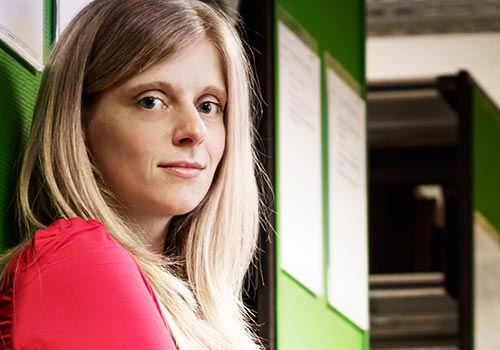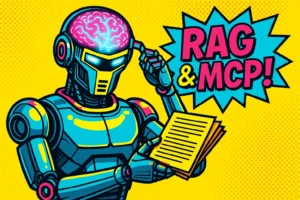devmio: Thank you for taking the time for the interview. Can you please introduce yourself to our readers?
Katleen Gabriels: My name is Katleen Gabriels, I am an Assistant Professor in Ethics and Philosophy of Technology at the University of Maastricht in the Netherlands, but I was born and raised in Belgium. I studied linguistics, literature, and philosophy. My research career started as an avatar in Second Life and the social virtual world. Back then I was a master student in moral philosophy and I was really intrigued by this social virtual world that promised that you could be whoever you want to be.
That became the research of my master thesis and evolved into a PhD project which was on the ontological and moral status of virtual worlds. Since then, all my research revolves around the relation between morality and new technologies. In my current research, I look at the mutual shaping of morality and technology.
Some years ago, I held a chair at the Faculty of Engineering Sciences in Brussels and I gave lectures to engineering and mathematics students and I’ve also worked at the Technical University of Eindhoven.
Stay up to date
Learn more about MLCON
devmio: Where exactly do philosophy and AI overlap?
Katleen Gabriels: That’s a very good but also very broad question. What is really important is that an engineer does not just make functional decisions, but also decisions that have a moral impact. Whenever you talk to engineers, they very often want to make the world a better place through their technology. The idea that things can be designed for the better already has moral implications.
Way too often, people believe in the stereotype that technology is neutral. We have many examples around us today, and I think machine learning is a very good one, that a technology’s impact is highly dependent on design choices. For example, the data set and the quality of the data: If you train your algorithms with just even numbers, it will not know what an uneven number is. But there are older examples that have nothing to do with AI or computer technology. For instance, a revolving door does not include people who need a walking cane or a wheelchair.
In my talks, I always share a video of an automatic soap dispenser that does not recognize black people’s hands to show why it is so important to take into consideration a broad variety of end users. Morality and technology are not separate domains. Each technological object is human-made and humans are moral beings and therefore make moral decisions.
Also, the philosophy of the mind is very much dealing with questions concerning intelligence, but with breakthroughs in generative AI like DALL-E, also, with what is creativity. Another important question that we’re constantly debating with new evolutions in technology is where the boundary between humans and machines is. Can we be replaced by a machine and to what extent?
devmio: In your book “Conscientious AI: Machines Learning Morals”, you write a lot about design as a moral choice. How can engineers or developers make good moral choices in their design?
Katleen Gabriels: It’s not only about moral choices, but also about making choices that have ethical impact. My most practical hands-on answer would be that education for future engineers and developers should focus much more on these conceptual and philosophical aspects. Very often, engineers or developers are indeed thinking about values, but it’s difficult to operationalize them, especially in a business context where it’s often about “act now, apologize later”. Today we see a lot of attempts of collaboration between philosophers and developers, but that is very often just a theoretical idea.
First and foremost, it’s about awareness that design choices are not just neutral choices that developers make. We have had many designers with regrets about their designs years later. Chris Wetherell is a nice example: He designed the retweet button and initially thought that the effects of it would only be positive because it can increase how much the voices of minorities are heard. And that’s true in a way, but of course, it has also contributed to fake news to polarization.
Often, people tend to underestimate how complex ethics is. I exaggerate a little bit, but very often when teaching engineers, they have a very binary approach to things. There are always some students who want to make a decision tree out of ethical decisions. But often values clash with each other, so you need to find a trade-off. You need to incorporate the messiness of stakeholders’ voices, you need time for reflection, debate, and good arguments. That complexity of ethics cannot be transferred into a decision tree.
If we really want to think about better and more ethical technology, we have to reserve a lot of time for these discussions. I know that when working for a highly commercial company, there is not a lot of time reserved for this.
devmio: What is your take on biases in training data? Is it something that we can get rid of? Can we know all possible biases?
Katleen Gabriels: We should be aware of the dynamics of society, our norms, and our values. They’re not static. Ideas and opinions, for example, about in vitro fertilization have changed tremendously over time, as well as our relation with animal rights, women’s rights, awareness for minorities, sustainability, and so on. It’s really important to realize that whatever machine you’re training, you must always keep it updated with how society evolves, within certain limits, of course.
With biases, it’s important to be aware of your own blind spots and biases. That’s a very tricky one. ChatGPT, for example, is still being designed by white men and this also affects some of the design decisions. OpenAI has often been criticized for being naive and overly idealistic, which might be because the designers do not usually have to deal with the kind of problems they may produce. They do not have to deal with hate speech online because they have a very high societal status, a good job, a good degree, and so on.
devmio: In the case of ChatGPT, training the model is also problematic. In what way?
Katleen Gabriels: There’s a lot of issues with ChatGPT. Not just with the technology itself, but things revolving around it. You might already have read that a lot of the labeling and filtering of the data has been outsourced, for instance, to clickworkers in Africa. This is highly problematic. Sustainability is also a big issue because of the enormous amounts of power that the servers and GPUs require.
Another issue with ChatGPT has to do with copyright. There have already been very good articles about the arrogance of Big Tech because their technology is very much based on the creative works of other people. We should not just be very critical about the interaction with ChatGPT, but also about the broader context of how these models have been trained, who the company and the people behind it are, what their arguments and values are, and so on. This also makes the ethical analysis much more complex.
The paradox is that on the Internet, with all our interactions, we become very transparent for Big Tech companies, but they in turn remain very opaque about their decisions. I’ve also been amazed and but annoyed about how a lot of people dealt with the open letter demanding a six-month ban on AI development. People didn’t look critically at people like Elon Musk signing it and then announcing the start of a new AI company to compete with OpenAI.
This letter focuses on existential threats and yet completely ignores the political and economic situation of Big Tech today.
devmio: In your book, you wrote that language still represents an enormous challenge for AI. The book was published in 2020 – before ChatGPT’s advent. Do you still hold that belief today?
Katleen Gabriels: That is one of the parts that I will revise and extend significantly in the new edition. Even though the results are amazing in terms of language and spelling, ChatGPT still is not magic. One of the challenges of language is that it’s context specific and that’s still a problem for algorithms, which has not been solved with ChatGPT. It’s still a calculation, a prediction.
The breakthrough in NLP and LLMs indeed came sooner than I would have expected, but some of the major challenges are not being solved.
devmio: Language plays a big role in how we think and how we argue and reason. How far do you think we are from artificial general intelligence? In your book, you wrote that it might be entirely possible, that consciousness might be an emergent property of our physiology and therefore not achievable outside of the human body. Is AGI even achievable?
Katleen Gabriels: Consciousness is a very tricky one. For AGI, first of all, from a semantic point of view, we need to know what intelligence is. That in itself is a very philosophical and multidimensional question because intelligence is not just about being good in mathematics. The term is very broad. There is also emotional and different kinds of intelligence, for instance.
We could take a look at the term superintelligence, as the Swedish philosopher Nick Bostrom defines it: Superintelligence means that a computer is much better than a human being and each facet of intelligence, including emotional intelligence. We’re very far away from that. It also has to do with bodily intelligence. It’s one thing to make a good calculation, but it’s another thing to teach a robot to become a good waiter and balance glasses filled with champagne through a crowd.
AGI or strong AI means a form of consciousness or self-consciousness and includes the very difficult concept of free will and being accountable for your actions. I don’t see this happening.
The concept of AGI is often coupled with the fear of the singularity, which is basically a threshold: The final thing we as humans do, is develop a very smart computer and then we are done for as we cannot compete with these computers. Ray Kurzweil predicted that this is going to happen in 2045. But depending on the definition of superintelligence and the definition of singularity, I don’t believe that 2045 will be the time when this happens. Very few people actually believe that.
devmio: We regularly talk to our expert Christoph Henkelmann. He raised an interesting point about AGI. If we are able to build a self-conscious AI, we have a responsibility to that being and cannot just treat it as a simple machine.
Katleen Gabriels: I’m not the only person who made the joke, but maybe the true Turing Test is that if a machine gains self-consciousness and commits suicide, maybe that is a sign of true intelligence. If you look at the history of science fiction, people have been really intrigued by all these questions and in a way, it very much fits the quote that “to philosophize is to learn how to die.”
I can relate that quote to this, especially the singularity is all about overcoming death and becoming immortal. In a way, we could make sense of our lives if we create something that outlives us, maybe even permanently. It might make our lives worth living.
At the academic conferences that I attend, the consensus seems to be that the singularity is bullshit, the existential threat is not that big of a deal. There are big problems and very real threats in the future regarding AI, such as drones and warfare. But a number of impactful people only tell us about those existential threats.
devmio: We recently talked to Matthias Uhl who worked on a study about ChatGPT as a moral advisor. His study concluded that people do take moral advice from a LLM, even though it cannot give it. Is that something you are concerned with?
Katleen Gabriels: I am familiar with the study and if I remember correctly, they required a five minute attention span of their participants. So in a way, they have a big data set but very little has been studied. If you want to ask the question of to what extent would you accept moral advice from a machine, then you really need a much more in-depth inquiry.
In a way, this is also not new. The study even echoes some of the same ideas from the 1970s with ELIZA. ELIZA was something like an early chatbot and its founder, Joseph Weizenbaum, was shocked when he found out that people anthropomorphized it. He knew what it was capable of and in his book “Computer Power and Human Reason: From Judgment to Calculation” he recalls anecdotes where his secretary asked him to leave the room so she could interact with ELIZA in private. People were also contemplating to what extent ELIZA could replace human therapists. In a way, this says more about human stupidity than about artificial intelligence.
In order to have a much better understanding of how people would take or not take moral advice from a chatbot, you need a very intense study and not a very short questionnaire.
devmio: It also shows that people long for answers, right? That we want clear and concise answers to complex questions.
Katleen Gabriels: Of course, people long for a manual. If we were given a manual by birth, people would use it. It’s also about moral disengagement, it’s about delegating or distributing responsibility. But you don’t need this study to conclude that.
It’s not directly related, but it’s also a common problem on dating apps. People are being tricked into talking to chatbots. Usually, the longer you talk to a chatbot, the more obvious it might become, so there might be a lot of projection and wishful thinking. See also the media equation study. We simply tend to treat technology as human beings.
Stay up to date
Learn more about MLCON
devmio: We use technology to get closer to ourselves, to get a better understanding of ourselves. Would you agree?
Katleen Gabriels: I teach a course about AI and there’s always students saying, “This is not a course about AI, this is a course about us!” because it’s so much about what intelligence is, where the boundary between humans and machines is, and so on.
This would also be an interesting study for the future of people who believe in a fatal singularity in the future. What does it say about them and what they think of us humans?
devmio: Thank you for your answers!






